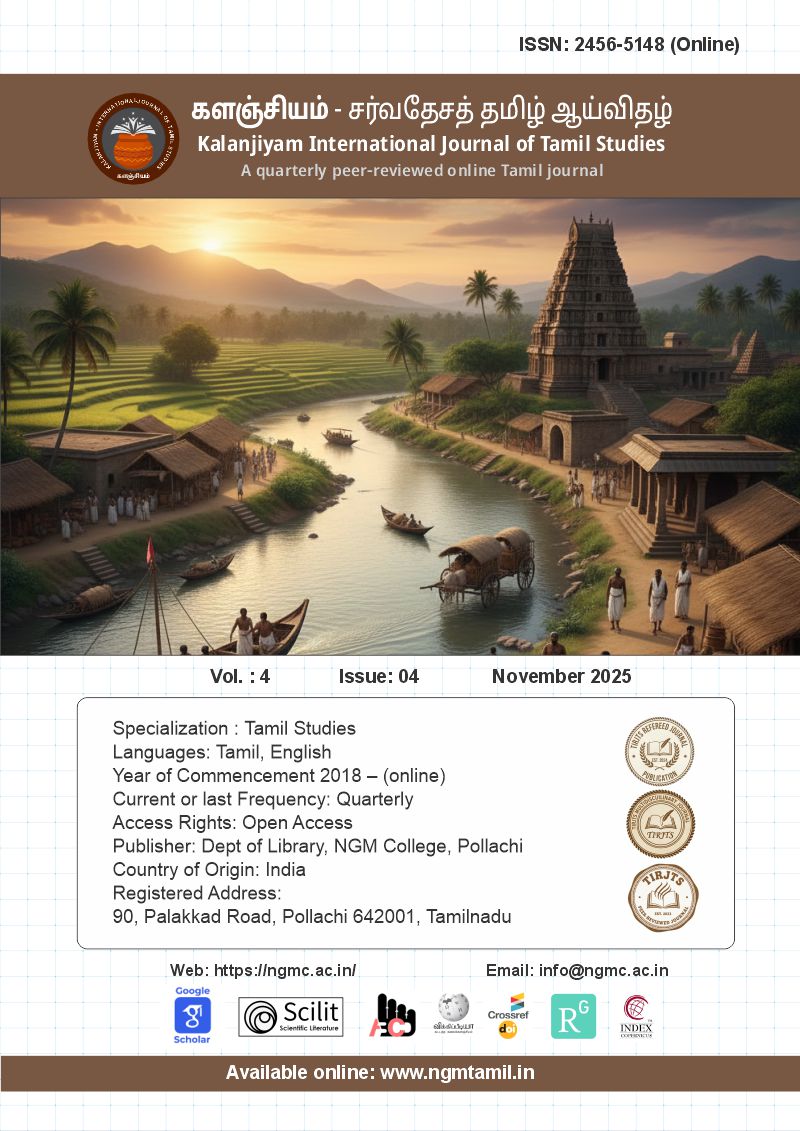சங்ககால கலைஞர்களின் பொருளாதாரப் பின்னணியும் சமூகமதிப்பும்
The Economic Background and Social Status of Sangam Period Artists
Keywords:
Artist, Panan, Virali, Mannan, Naalmahikhirukkai, Media, கலைஞன், பாணன், விறலி, நாள்மகிழிருக்கைAbstract
The fundamental link between humanity and the arts is explored, positing that artistic expression is a primal, innate desire for communicating inner thought. As human societies developed, giving rise to distinct social divisions and structured communal life, the arts evolved synergistically with these internal social environments. This evolution transformed art from mere personal expression into a powerful societal mirror and medium.
This paper investigates the role of arts, particularly in the Sangam period of ancient Tamilakam, as a crucial source for understanding the culture, political dynamics, economic structures, and daily life of the society. The study specifically focuses on the biographies and social roles of Sangam-era artists, such as the Panan (male minstrel) and the Virali (female minstrel/performer). Figures like the Mannan (King) and concepts such as Naalmahikhirukkai (perhaps referring to a place of royal entertainment or assembly) are examined to establish the artists' relationship with power structures and their function as the period's primary media and chroniclers. By analyzing their lives as depicted in classical texts, the paper seeks to demonstrate how the arts served as an essential, dynamic document of Sangam socio-political life.
மனிதன் தோன்றிய நாள் முதலே கலைகளும் அவனுள் பிறப்பெடுத்தன. இயற்கையாகவே, மனிதன் தன் உள்ளத்தில் தோன்றும் எண்ணங்களை வெளிப்படுத்த வேண்டுமென்ற விருப்பம் மிகுந்தவனாகவே காணப்பட்டான். அவ்வெண்ணங்களின் வெளிப்பாடே கலைகளாகவும் உருவெடுத்தன. சமூக வாழ்வியலின் அடிப்படையில் சமூகப் பிரிவுகள் தோன்றின. அச்சமூகத்தில் அகப்புற சூழலுக்கு ஏற்றவாறு கலைகளும் பரிணமித்தன. அவ்வாறு உருவான கலைகள் சமூகத்தின் பண்பாட்டினையும், அரசியலையும், பொருளாதாரத்தையும் பிற்செயற்பாடுகளையும் விளக்குவதாக அமைந்துள்ளன. இதனை சங்ககால கலைஞர்களின் வாழ்வியலோடு ஆராய முற்படுகிறது.
Downloads
References
1. Akananuru.
2. Navaneethakrittinan. Atrupaadi. Pages 308-309.
3. Perumbanatrupadai. Page 90.
4. Perumbanatrupadai. Page 181.
5. Porunarararupadai. Page 87.
6. Purananuru. Page 650.
7. Purunanurupadai. Pages 82-83.
8. Thol. Cheruliyal. Page 864.
9. Kothandaraman. Indian Arts. Page 8.
10. Kothandaraman. Indian Arts. Page 2.
11. Sirupanatrupadai. Page 140.
12. Sirupanatrupadai. Pages 129-130.
13. Thirunavukkarasu. Thirukkural Neethi Ilakyam. Pages 119-126.
Downloads
Published
Issue
Section
License

This work is licensed under a Creative Commons Attribution 4.0 International License.
Our journal adopts CC BY License Creative Commons Attribution 4.0 International License http://Creativecommons.org//license/by/4.0/ . It allows using, reusing, distributing and reproducing of the original work with proper citation.


